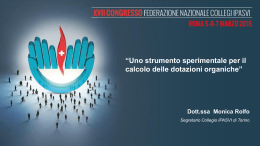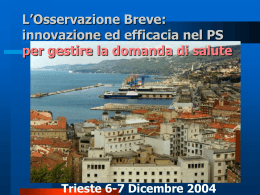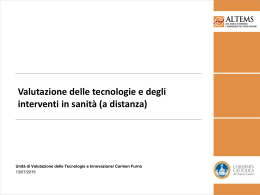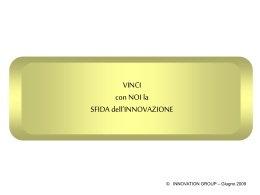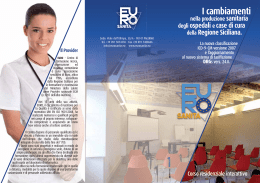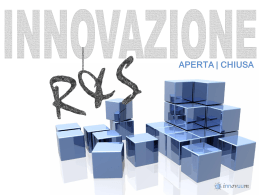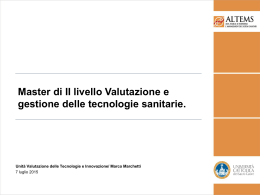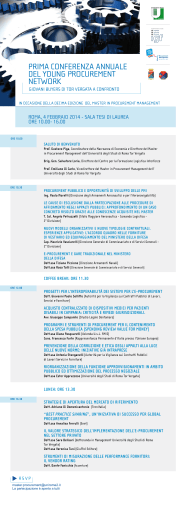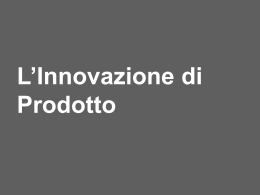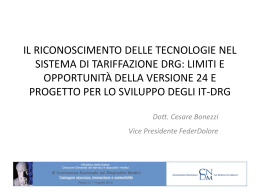Barriers to Innovation in Medical Devices Restrictions in health care budgets – the view of the industry Markus Siebert Director Reimbursement & Health Economics EMEAC, St Jude Medical Chair Economic Affairs Group, Eucomed Society Healthcare DRG Hospital Hospital Procurement is moving to become more centralised and more professionalised. As result, shortterm focus on price is increasing, at the expense of a full eVALUation. Impact of intensified focus of purchasing on device cost The German example ● Intensified business through purchasing consortiums and hospital groups (2009: 70%) ● Hospital devices price erosion of 30% in 3 years (’02-’05 about 10% p.a.) Preliminary conclusion: ● It pays off. More balanced conclusion: ● Reduced competition leads to decreased offerings (e.g. Helios -> de facto 1 interested supplier only for CRM) ● PC/HG have delayed access to latest technologies (so reduction in patient’s access to innovations) ● Reduced investments in service, training & education organized by industry ● Lowered DRG of CRM devices causes downward spiral affecting profitability as since 2007 no more price gains ● As a consequence, intensified focus on other costing elements to sustain profitability Source: SK&P report for BVMed, 2005 Economic Affairs 2011 Value Based Purchasing Project Team Objectives Improve Med Tech Industry understanding of the current use of HTAs or health economic arguments in purchasing decisions of medical devices. Activities 2011 Research proposal • Follow up with the Commission on our submission • Proposal to Assobiomedica to set up a pilot of the research in e.g. A region in Italy HELP Workshop: “What is the role of Health Economics and “micro-HTA” in purchasing decisions of medical devices?” • Set up a second workshop in Q1 of 2012. It could be with speakers from regional procurement, GPOs, end-users etc. • Input for the EAG activity at the Medtech Forum 2011: Focus on the iTAPP project? EC Public consultation on the modernisation of the European Public Procurement Market • Participate in the consultation of the green paper Collaboration/coordination with the new Procurement Group at Eucomed • Attend meetings in the Procurement Group • Consider if we need a new name for our WG: Purchasing and Health Economics? Many physicians loose their influence in the procurement process to the administrators and to new roles of professional purchasing staff inside the hospital SJM « Nordic Clinical Advisory Board » Recommendations The procurement process: 1. «Nurses are central in the purchasing process, but often not educated well enough on the clinical and economic value of devices. Develop tools that will help to reach out to them.» 2. «Often the doctors are not part of the procurement process. Can industry request that they are heard? Develop a cross-industry set of recommendations/best practise in procurement that could serve as gold standard at Eucomed or ESC/EHRA level.» 3. «There is a communication gap between physicians and administrators. Help us to overcome this by giving us material in the shape and formate that they need and understand.» 4. «The physical process of formulating and submitting requests for new devices to the administration is tedious and burdensome for doctors.« Countries are moving to DRG, thus introducing market mechanism. DRG systems are inherently backwardlooking with a negative impact on innovation. Why DRGs are not good for innovation Data collection year x DRG calculation year x+1 new DRG-catalogue year x+2 Determination of the average DRG cost (-> billing price, DRG weight) various total costs per individual patients expensive inexpensive cost per patient “untrimmed” average I phase outliers < - 3 SD II phase outliers < - 2 SD “trimmed” average DRG cost II phase outliers > +2 SD I phase outliers > +3 SD Jorma Lauharanta Most countries offer supplemental payments – but eligibility can require substantial evidence Country System Germany Exclusions? Additional Payment? G-DRG Yes Yes- Innovation Clause (NUB) UK HRG Yes Yes – Innovation Payment France GHS Yes Yes – Supplements Italy DRG Yes Yes Portugal DRG Yes TBD 8° Congresso Nazionale AIAC, 15-17 Aprile 2010 Documento AIAC di “Health Technology Assessment” della terapia ablativa della Fibillazione atriale Dr Sakis Themistoclakis Dipartimento Cardiovascolare, Ospedale dell’Angelo, Mestre18 Venezia I Centri della Survey AIAC 2 12 1 ● 4 1 1 consumi costi ● ● 8 3 ● 2 1 52/87 Centri hanno fornito le risposte al questionario sui consumi 4 Centri hanno partecipato all’analisi di costing delle risorse ● 6 1 5 3 1 1 Costo INTRAOSPEDALIERO dell’ablazione Costo medio di produzione pesato in funzione della casistica: € Giornate ricovero 8.848,8 € 10,000 Attrezzatura Sala Costi intra-procedurali Materiale di consumo Voci di costo più significative: € 8,000 Materiali di consumo: 59 % Degenza: 13 % € 6,000 Occupazione sala e personale: 12% € 4,000 Attrezzatura Sala: 3,6% Esami: 3,4% € 2,000 €0 Esami e test pre-operatori Costo Intraospedaliero della procedura ablativa Analisi Regionale per voci di costo: Giornate di degenza Attrezzatura Sala 14.000 Costi intra-procedurali Materiale di consumo Esami e test 12.000 10.000 8.000 6.000 4.000 2.000 Tutti i Centri LOM VEN LAZ PUG PIE CAM E.R. TN UMB Confronto Costo medio di Procedura e Analisi Regionale: DRG Costo Totale 14.000 DRG 518 12.000 10.000 8.000 6.000 4.000 2.000 Tutti i Centri LOM VEN LAZ PUG PIE CAM E.R. TN UMB Conclusioni La FA, considerata la sua epidemiologia, morbidità e mortalità, rappresenta un significativo problema sanitario ed ha un importante impatto sociale ed economico che richiede più attenzione e risorse rispetto a quelle destinate finora. Budget Impact Analysis AF ablation Italy Blue line: total costs for AF ablation Red line: total savings from AF ablation Yellow line: Net savings from AF 24 HTA is here to stay in an increasing amount of markets and we see increasing level of European and international collaboration on methods, structures and results. The impact of HTA on market access and reimbursement is increasing. Health Technology Assessment is already here to stay Economic Affairs 2011 HTA Project Team Theme European HTA Collaboration Objectives Strengthen our position as trusted stakeholders for international HTA networks, local agencies as well as other stakeholders connected to those networks in the field of HTA. Deliverables EUnetHTA − Involvement in the Stakeholder Forum − Involvement in WPs 4, 5 and 7 − Involvement in the development of the second Joint Action. European Commission − 2012 high-level conference on HTA (to be prepared in Q3 – Q4 2011); − Cross-border directive − Transparency directive Events − HTAi 2012 (Bilbao) − Workshop for NAs and/or presentations during meetings − MedTech Forum EHRA Committee on Health Economics and Outcomes 2009-2011 Chair Giuseppe Boriani (IT) Co-chair Nikos Maniadakis (GR) Members Frieder Braunschweig (SE) Haran Burri (CH) Giovanni Fattore (IT) Joseph Kautzner (CZ) Werner Jung (DE) Francisco. Levya (UK) Andrej Lubinski (PL) Lorenzo Mantovani (IT) Name of the speaker Initiatives of our Committee A “focus issue” of Europace CARDIAC ELECTROPHYSIOLOGY: WHY AND HOW TO APPROACH HEALTH ECONOMICS? Sponsors: Device companies Available November 2010-Spring 2011 (to be discussed) Angelo Auricchio “Ageing of the population, and its associated health and caring costs, is indeed one of the major issues faced by governments especially at a time of fiscal consolidation. It is both a challenge and an opportunity. It is an opportunity because the most important sectors for growth in the next decades are linked to the development of human and social capital: for example, health already represents a large share of GDP in most countries. And in many EU countries, elder care alone is due to reach 5% of GDP in a few years. It is an area where we need to maintain and even increase public investment in research and innovation. This is to invest in the future. […] It is also a challenge because we need to bring public and private stakeholders together to identify and deploy innovative solutions to address such an issue that is shared throughout the European Union. Together, we need for example to make the most and the best of the potential of information and communication technologies (ICTs) for improving our ability to meet those social needs, such as e-Health in healthcare. […] Active and healthy ageing is precisely our pilot Innovation Partnership. It will aim to give Europeans an average of two extra years of healthy life by 2020. So most of us will benefit from this innovation initiative. […]” In conclusion The impact of restricted health care budgets can be seen at various levels from hospital to society. Industry is not shy to accept the challenge and to document the value of its technology solutions. However a pre-requisite for that is an appropriate, holistic definition of what creates value and transparent approach of assessing value, based on full stakeholder involvement, incl industry. Effective partnership with individual clinician-experts in their capacity as customers, but certainly also with scientific organisations is critical for medical technology innovation to stand its case. Thank you [email protected] +32 476 565 101
Scarica
